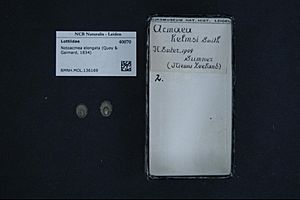Notoacmea elongata facts for kids
Quick facts for kids Notoacmea elongata |
|
|---|---|
 |
|
| Scientific classification | |
| Kingdom: | |
| Phylum: | |
| Class: | |
| (unranked): |
clade Patellogastropoda
|
| Superfamily: |
Lottioidea
|
| Family: |
Lottiidae
|
| Genus: | |
| Species: |
N. elongata
|
| Binomial name | |
| Notoacmea elongata (Quoy & Gaimard, 1834)
|
|
| Synonyms | |
|
|
Notoacmea elongata is a type of sea snail known as a true limpet. It's a marine gastropod mollusk that belongs to the family Lottiidae. This family includes many true limpets, which are sea snails with a special cone-shaped shell.
Contents
What is Notoacmea elongata?
Notoacmea elongata is a small, fascinating creature that lives in the ocean. It's often found clinging tightly to rocks. Like all limpets, it has a strong, muscular foot that helps it stick to surfaces and move around. Its shell protects it from predators and the harsh conditions of the ocean.
Shell and Appearance
The shell of Notoacmea elongata is shaped like a low cone or cap. This shape helps it withstand strong waves and currents. The shell can vary in color, often blending in with the rocks it lives on. This camouflage helps it hide from birds and other animals that might want to eat it.
How Limpets Eat
Limpets like Notoacmea elongata are herbivores, meaning they eat plants. They use a special ribbon-like tongue called a radula to scrape tiny algae off rocks. Imagine a tiny file that helps them get their food! They move slowly across the rock surface, grazing as they go.
Where Notoacmea elongata Lives
This specific limpet, Notoacmea elongata, is found in the waters around New Zealand. It prefers to live on rocky shores in the intertidal zone. This is the area between the high and low tide marks, which means it's sometimes covered by water and sometimes exposed to the air.
Adapting to the Tides
Living in the intertidal zone is tough! When the tide goes out, Notoacmea elongata must be able to survive being out of water. It does this by clamping its shell tightly to the rock, trapping moisture inside. This keeps its soft body from drying out. When the tide comes back in, it can start moving and feeding again.

